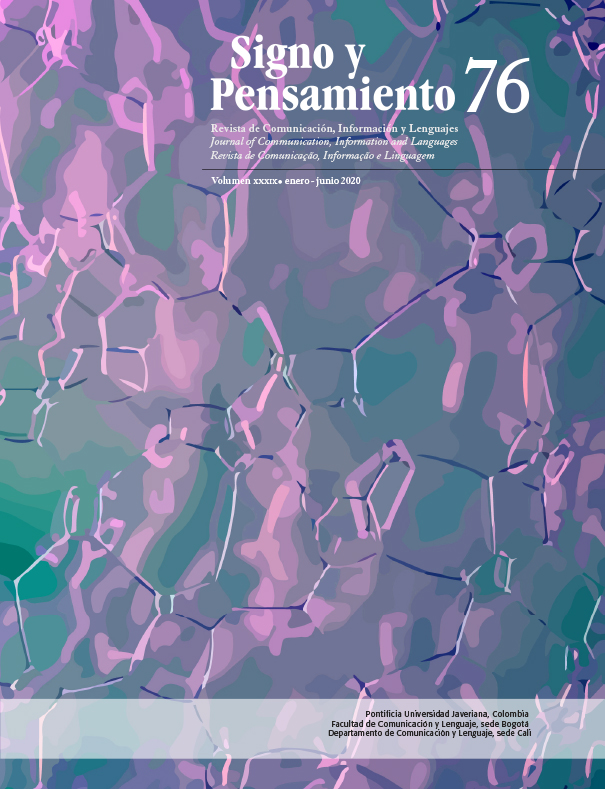Resumen
Desde inicios de la década de 1990 comenzará a resquebrajarse la noción de inmaterialidad asociada a las realidades digitales. Este artículo presenta un esquema interpretativo que permite acceder a tres vertientes discursivas que han construido distintas formas de pensar las relaciones entre realidades digitales y materialidades en el campo de la comunicación. En primer lugar, el estudio se detiene en discursos que, en contacto con prácticas de diseño, inscriben como vórtice de sus problematizaciones al carácter encarnado de la producción de sentido. En segundo lugar, la investigación examina perspectivas sobre las dinámicas entre hardware y software (giro material, arqueologías de los medios), al tiempo que aborda trabajos sobre la infraestructura de los sistemas de información y de comunicación. Por último, el artículo interpela el vínculo entre materialidad de los medios (milieux), información y objetos digitales, así como sus consecuencias para pensar la individuación psíquica y colectiva en el capitalismo contemporáneo.
Barker, T. y McKeown, C. (2015). Unearthing Techno-Ecology. Digital Culture & Society, 1(1), 21-38.
Barreneche, C. (2013). Jussi Parikka, What Is Media Archaeology? Media, Culture & Society. 1029-1032.
Blanchette, J. (2011).A material history of bits. ASIST, 62 (6), 1042-1057.
Blanco, J. y Berti, A. (2018). No hay hardware sin software. Quadranti, 4 (4), 197 – 214.
Bogost, I.y, Montfort, N. (2007). New media as material constraint. An introduction to platform studies. Proceedings of the HASTAC Conference. 176-193.
Cardon, D. (2015). A quoi rêvent les algorithmes. París: Le Seuil.
Casemajor, N. (2015). Digital Materialisms. Westminster Papers in Communication and Culture, 10(1), 4-17.
Citton, Y. (2014). Les Lumières de l'archéologie des media. Dix-huitième siècle, (1), 31-52.
Deleuze, G. y Guattari, F. (1997). Mil Mesetas. Valencia: Pre-textos.
Coole, D. y Frost S. (2010). New materialisms. Durham: Duke University Press.
Dourish, P. (2001). Where the action is. Cambridge: MIT Press.
Dourish, P. y Mazmanian, M. (2011). Media as Material. Third international symposium on process organization studies. Recuperado de: http://www.academia.edu/download/32271057/dourish_mazmanian_materiality_final_book_submission.pdf
Ekman, U., Bolter, J. D., Díaz, L., Søndergaard, M., y Engberg, M. (2016). Ubiquitous Computing, Complexity, and Culture. New York: Routledge. Ernst, W. (2016). Chronopoetics. Londres: R&L International.
Floridi, L. (2014). The fourth revolution. Oxford: OUP.
Forlano, L. (2015). Towards an integrated theory of the cyber-urban. Digital Culture & Society, 1(1), 73-92.
Fuller, M.(ed.) (2008). Software studies: a lexicon. Cambridge: MIT Press.
Ganahl, S. (2015). Poetiken der Infrastruktur oder Foucault und Materialität, Le foucaldien, 1(1) DOI: 10.16995/lefou.6
Gaver, W. (1991). Technology affordances. Proceedings of the SIGCHI ACM. 79-84.
Gibson, J. (1986). The Ecological Approach to Visual Perception. Nueva York: Taylor & Francis.
Hansen, M. (2004). New Philoshophy for New Media. Cambridge: MIT Press.
Hayles, N. (1993). The materiality of informatics. Configurations, 1(1), 147-170.
Heilmann, T. A. (2015). Reciprocal Materiality and The Body of Code. Digital Culture & Society, 1(1), 39-52.
Hillis, K. (1999). Digital sensation. Minneapolis: University of Minnesota Press.
Hoppe, K. y Lipp, B. (2017). Neue Materialismen. BEHEMOTH, 10 (1), 2-9.
Huhtamo, E. y Parikka, J. (2011). Media archaeology. Berkeley: University of California Press.
Hui, Y. (2015). Towards A Relational Materialism. Digital Culture & Society, 1(1), 131-148.
Hui, Y. (2016). On the existence of digital objects. Minneapolis: UMP.
Hutchby, I. (2001). Conversation and technology. Malden: Wiley-Blackwell.
Jahjah, M. (2017). De la bibliographie matérielle aux “Digital Studies”?. Revue francaise des sciences de l'information et de la communication, 1-20, DOI :10.4000/rfsic.1968.
Kaptelinin, V. y Nardi, B. (2006). Acting with technology. Cambridge: MIT Press.
Karafillidis, A. (2017). Die Materie der Kybernetik. BEHEMOTH, 10(1), 130-153.
Khosrow-Pour, M. (ed.) (2018). Encyclopedia of Information Science and Technology. 4ta ed. Hershey: IGI Global.
Kirschenbaum, M. G. (2008). Mechanisms. Cambridge: MIT Press.
Kirschenbaum, M., Werner, S. (2014). Digital scholarship and digital studies. Book History, 17(1), 406-458.
Kittler, F. (2018). La verdad del mundo técnico. México: FCE.
Leonardi, P. (2010) Digital materiality? How artifacts without matter, matter. First monday, 2010, 15(6).
Manovich, L. (2011). El lenguaje de los nuevos medios de comunicación. Barcelona: Paidós.
Meldgaard, B. (2011). Dangerous Forms (tesis doctoral). Aalborg University, Dinamarca.
Mosco, V. (2017). Becoming digital. Bingley: Emerald Limited.
Norman, D. (1990). La psicología de los objetos cotidianos. Madrid: Nerea.
O´ Neil, S. (2008). Interactive Media. Londres: Springer.
Parikka, J. (2012). La nueva materialidad del polvo. Artnodes, (12), 24-29.
Parikka, J. (2013). What is media archaeology? Hoboken: Wiley.
Parikka, J. (2015). A geology of media. Minneapolis: UMP.
Passoth, J. H. (2017). Hardware, Software, Runtime. Das Politische der (zumindest) dreifachen Materialität des Digitalen. BEHEMOTH, 10(1), 57-73.
Petit, V. y Guillaume, B. (2018). We Have Never Been Wild. En: Loeve, S., Guchet, X. y Bensaude, B. French Philosophy of Technology, Cham: Springer.
Peters, J. D. (2015). The Marvelous Clouds. Chicago:UCP.
Reichert, R. y Richterich, A. (2015). Digital Material/ism. Digital Culture & Society, 1 (1), 5-17.
Rogers, Y. (2012). HCI Theory. Winterspot: Morgan & Claypool.
Rossi, L. S. (2018a). Agenciamientos en las sociedades de control. CUHSO, Chile, 28 (1), 177-206.
Rossi, L.S. (2018b). El modo de existencia de las imágenes a la luz de Simondon Reflexiones Marginales, (48, Dossier). Recuperado de: https://2018.reflexionesmarginales.com/el-modo-de-existencia-de-las-imagenes-a-la-luz-de-simondon/
Rossi, L.S. (2020). Perspectivas sobre la computación ubicua. Paakat, 10(18), 1-24.
Simondon, G. (2009) La individuación. Buenos Aires: Cactus-Cebra.
Spitzer, L. (1942). Milieu and Ambiance. Philosophy and Phenomenological Research, Parte I: 3(1), 1-42 y Parte II: 3(2), 169-218.
Stiegler, B. (2008). Économie de l'hypermatériel et psychopouvoir. París: Mille et une nuits.
Van den Boomen, M (2009). Digital material. Amsterdam University Press.
Werning, S. (2015). Swipe to unlock. Digital Culture & Society, 1(1), 55-71.
Wertsch, J. (1999). La mente en acción. Buenos Aires: Aique.
Yoo, Y. (2012). Digital Materiality and the Emergence of an Evolutionary Science of the Artificial. 134-154. Recuperado de: http://www.orgdna.net/wp-content/uploads/2011/10/Yoo-Digital-Materiality-and-Evolutionary-Science.pdf

Esta obra está bajo una licencia internacional Creative Commons Atribución 4.0.
Derechos de autor 2020 Luis Sebastián R. Rossi



